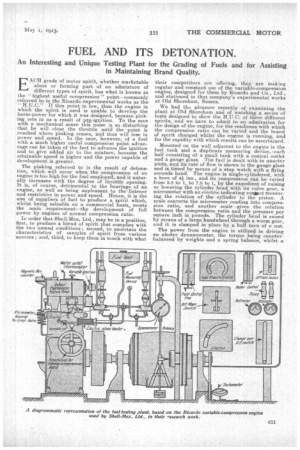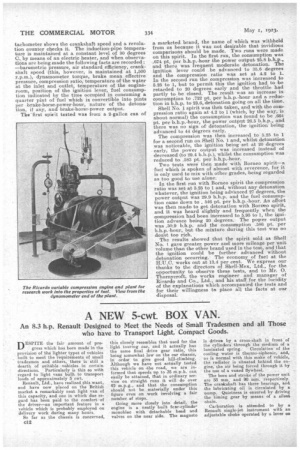FUEL AND ITS DETONATION.
Page 11

Page 12

If you've noticed an error in this article please click here to report it so we can fix it.
An Interesting and Unique Testing Plant for the Grading of Fuels and for Assisting in Maintaining Brand Quality.
• EACH grade of motor spirit, whether marketable
alone or forming part of an admixture of
different types of spirit, has what is known as the "highest useful compression" point—commonly referred to in the Ricardo experimental works as the " FI.U.C." If this point is low, then the engine in which the spirit is used is unable to develop the horse-power for which it was designed, because pinking sets in as a result of pr-ignition. To the man with a mechanical sense this noise is so disturbing that he will dose the throttle until the point is reached where pinking ceases, and thus will lose in power and speed. In the case, however, of a fuel with a much higher useful compression point advantage can be taken of the fact to advance the ignition and to give added air to the mixture, because the attainable speed is higher and the power capable of development is greater.
The pinking referred to is the result of detonation, which will occur when the compression of an engine is too high for the fuel employed, and it naturally increases with the degree of throttle opening. It is, of course, detrimental to the bearings of an engine, as well as being unpleasant to the' listener and restrictive in power and speed. Hence, it is the aim of suppliers of fuel to produce a spirit which, whilst being saleable on a commercial basis, meets the main requirement—the development of full power by engines of normal compression ratio.
In order that Shell-Mex, Ltd., may be in a position, first, to produce a blend of spirit that complies with the two named conditions ; second, to ascertain the characteristics of samples of spirit from various sources ; and, third, to keep them in touch with what
their competitors are offering, they are making regular and constant use of the variable-compression engine, designed for them by Ricardo and Co., Ltd., and stationed in that company's experimental works at Old Shoreham, Sussex.
We had the pleasure recently of examining the plant at Old Shoreham and of watching a series of tests designed to show the H.U.C. of three different spirits, and we have to admit to an admiration for the design of the engine, for the readiness with which the compression ratio can be varied and the brand of spirit changed whilst the engine is running, and for the rapidity with which results can be ascertained.
Mounted on the wall adjacent to the engine is the fuel tank and a duplicate measuring device, reach half consisting of a small tank with a conical outlet and a gauge glass. The fuel is dealt with in quarter pints, and its rate of flow is shown in the gauge glass and is timed by means of a stop watch with a flying seconds hand. The engine is single-cylindered, with a bore of 4i ins., and its compression can be varied from 3.8 to 1., to 7.8 to 1, by the expedient of raising or "lowering the cylinder head with its valve gear, a micrometer with an electric indicating conilact measuring the relation of the cylinder to the piston. A scale converts the micrometer reading into compression ratio, and another scale gives the relation between the compression ratio and the pressure per square inch in pounds. The cylinder head is raised by means of a large hand wheel through a worm gear, and it is clamped in place by a half turn of a nut.
The power from the engine is utilized in driving an electrc dynamometer, the torque being counterbalanced by weights and a spring balance, whilst a
tachometer shows the crankshaft speed and a revolution counter checks it. The induction-pipe temperature is maintained at a constant level of 30 degrees C_ by means of an electric heater, and when observations are being made the following facts are recorded : —barometric pressure, air standard efficiency, crankshaft speed (this, however, is maintained at 1,500 r.p.m.), dynamometer torque, brake mean effective pressure, compression ratio, temperature of the water at the inlet and outlet, temperature of the engineroom, position of the ignition lever, fuel consumption indicated by the time occupied in consuming a quarter pint of fuel which is convertible into pints per brake-horse-power-hour, nature of the detonation, if any, and brake-horse-power output.
The -first spirit tested was from a 2-gallon can of a marketed brand, the name of which was withheld from us because it was not desirable that invidious comparisons should be made. Two runs were made on this spirit. In the first run, the consumption was .674 pt. per b.h.p.-hour the power output 25.8 b.h.p., and there was frequent moderate detonation. The ignition lever eould be advanced to 35.6 degrees and the compression ratio was set at 4.2 to 1. In the second run the compression was increased to 5.25 to 1, but to permit this the ignition had to be retarded to 20 degrees early and the throttle had partly to be closed. The result was an increase inconsumption to .722 pt. per b.h.p.-hour and a reduction in b.h.p. to 23.6, detonation going on all the time.
Shell No. 1 spirit was then taken, and with the compression ratio again at 4.2 to 1 (which, by the way, is about normal) the consumption was found to be .664 pt. per b.h.p.-hour, the power output 26.5 b.h.p., and there was no sign of detonation, the ignition being advanced to 44 degrees early.
The compression was then increased to 5.25 to 1 for a second rim on Shell No. 1 and, whilst detonation was noticeable, the ignition being set at 20 degrees early, the power output was increased instead of decreased (to 29.4 b.h.p.), whilst the consumption was reduced to, .583 pt. per b.h.p.-hour.
Two tests were then made with Borneo spirit—a fuel which is spoken of almost with reverence, for it is only used to mix with other grades, being regarded as too good to use alone'.
In the first run with Borneo spirit the compression ratio was set at 5.25 to 1 and, without any detonation whatever, the ignition being advanced 27 degrees, the power output was 29.9 b.h.p. and the fuel consumption came down to. 546 pt. per b.h.p.-hour. An effort was then made to get detonation with Borneo spirit, and it was heard slightly and frequently when the compression had been increased to 5.95 to 1, the ignition advance being 20 degrees. The povver output was ,30.9 b.h.p. and the consumption .586 pt. per b.h.p.-hour, but the mixture during this test was no doubt too rich.
The results showed that the spirit sold as Shell No. I gave greater power and more mileage per unit volume than the other brand used in the test, and that the ignition could 'be further advanced without detonation occurring. The economy of fuel at the
works out at 13.4 per cent. We express our thanks to the directors of Shell-Mex, Ltd., for the opportunity to Acobserve these tests, and to Mr. 0. Thornycroft, the works engineer and manager of Ricardo and Co., Ltd.' and his staff for the lucidity of the explanations which accompanied the tests and for their willingness to place all the facts at our disposal.
































